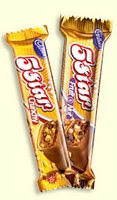Chocolate Market in India
 Facts & Figures
Facts & Figures 1. Chocolate market is estimated to be around 1500 crores (ACNielson) growing at 18-20% per annum
2. Cadbury is the market leader with 72% market share
3. The per capita consumption of chocolate in India is 300 gram compared with 1.9 kilograms in developed markets such as the United Kingdom
4. Over 70 per cent of the consumption takes place in the urban markets
5. Margins in the chocolate industry range between 10 and 20 per cent, depending on the price point at which the product is placed
6. Chocolate sales have risen by 15% in 2007 to reach 36000 tonnes according to one estimate. Another estimate puts the figure at 25000 tonnes
7. The chocolate wafer market (Ulta Perk etc) is around 35 % of the total chocolate market and has been growing at around 13% annually
8. As per Euromonitor study, Indian candy market is currently valued at around USD 664 million, with about 70%, or USD 461 million, in sugar confectionery and the remaining 30%, or USD 203 million, in chocolate confectionery
9. Entire Celebrations range marketshare is 6.5%
10. The global chocolate market is worth $75 billion annually
Companies
1. The chocolate market in India has only three big players, Cadbury, Nestle and Amul
2. New brands such as Sweet World, Candico and Chocolatiers are present in several malls
3. The largest target segment for Cadbury is youth
4. Delhi-based Chocolatiers, started with a small shop in south Delhi’s Chittaranjan Park and has now ventured into malls and multiplexes in NCR, Mumbai and Bangalore, with focus on high-end or designer chocolates, a niche market of their own
5. Candico India is aiming for 400 locations across malls and multiplexes in the country by 2010.
Companies & Brands
1. Cadbury - Cadbury, 5 Star, Bytes (chocolate snack), Celebration, Dairy Milk, Gems, Perk
2. Nestle - Bar One, Kit Kat, Milkybar, Munch, Nestle
3. Amul - Amul (Chocozoo, Chocomines)
4. Dairy Milk is the market leader
5. 5 Star (heritage brand which came to India in 1969) has a marketshare of over 14%
Consumer Trends
1. Mithai- the traditional Indian sweats is getting substituted by chocolates among upwardly mobile Indians. Instead of buying sweats on Raksha Bandhan, sisters prefer offering chocolates to their brothers. This is the reason for sudden spurt in advertisement between July & Sep by
 most of the companies
most of the companies2. The range and variety of chocolates available in malls seems to be growing day by day, which leads to lot of impulse sales for chocolate companies
3. Chocolates which use to be unaffordable, is now considered mid-priced. Convenience over Mithai in terms of packaging and shelf life in making both middle class and rich Indians opt for chocolates
4. Designer chocolates have become status symbols. They are linked to one’s aspiration and lifestyle and malls are perfect points of sale as people usually are happy and gay at these destinations
5. Cadbury initial communication for Celebrations was concentrated on occasions like Diwali and Rakshabandhan. Over the last seven to eight years, the brand emerged as a good gift proposition for occasions and enabled people to come closer. Research done by Cadbury suggested that they should extend the plank of occasion-based gifting to social gifting i.e. all-year-round gifting options
6. Consumers can choose from wide range of chocolates, which initially was limited to Milk chocolates like DairyMilk and MilkyBar. In past few years we have seen so many SKUs with almonds, raisins and all sort of nuts. And how can we forget latest 5 star crunchy and Ulta Perk, which has opened new windows for consumers
7. In past, consumers had negligible inclination for dark chocolates. But now we have seen a change in the Indian palate, which is increasing the base of this sub-segment
Advertisement Trends (AdEx - division of TAM Media Research)
1. Chocolate advertising rose by 30 per cent during January-November 2007 compared to January-November 2006
2. Maximum chocolate advertising was during Raksha Bandhan across 2005 and 2006 and January-November 2007
3. As expected chocolate advertising skewed towards kids channels and regional GEC took the second position
4. Cadbury India Ltd rules chocolate advertising on television
5. 17 per cent more advertising during third quarter 2007 (Raksha Bandhan festival) compared to first quarter 2007
6. Regional GEC took the second place with a 21 per cent share ad volumes of chocolates, followed by Hindi movie with 13 per cent share during January-November 2007
7. Among regional GEC, maximum advertising of chocolates was on Malayalam and Bengali channels
8. Cadbury India Ltd was way ahead of its peers with 66 per cent share followed by Nestle India Ltd and Parle Products Pvt Ltd during January-November 2007
9. During January-November 2007 the number of new chocolate brands advertised decreased to seven from 12 during 2006
10. Nestle Munch Pop Chocolate led the chart of new chocolate brands advertised on television during January-November 2007
Some BTL Activities
1. Cadbury India has tied up with leading coffee chain Café Coffee Day for direct sampling of the product in top cities
External Environment
1. The prices of cocoa and milk, the chief ingredients used in chocolates, have gone up by 50 per cent, while the price of sugar, another important raw material, has come down. The overall input costs have gone up by 20 per cent. If the prices of these commodities keep increasing, companies will be forced to increase the prices. India imports most of its cocoa requirements. The prices of cocoa have risen globally due to unavailability of the commodity
2. US-based chocolate-maker Hersheys is mulling a foray into the Indian chocolate market through its joint venture with Godrej
Labels: advertisement trends, chocolate, consumer trends, FMCG










